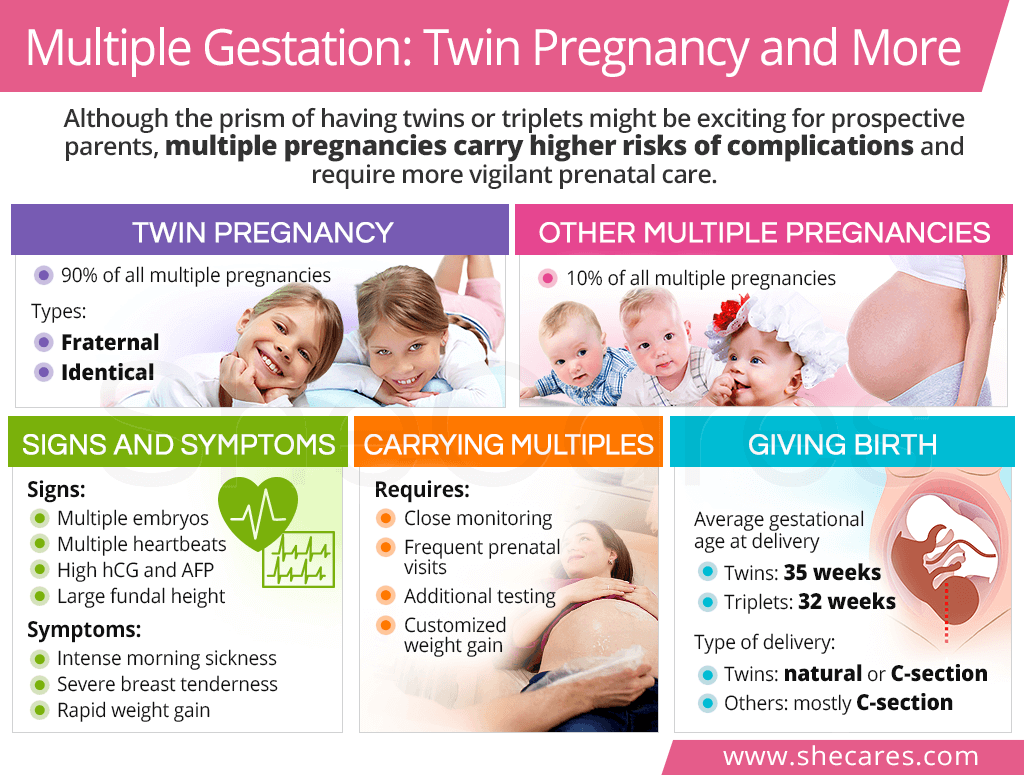Twin Pregnancy
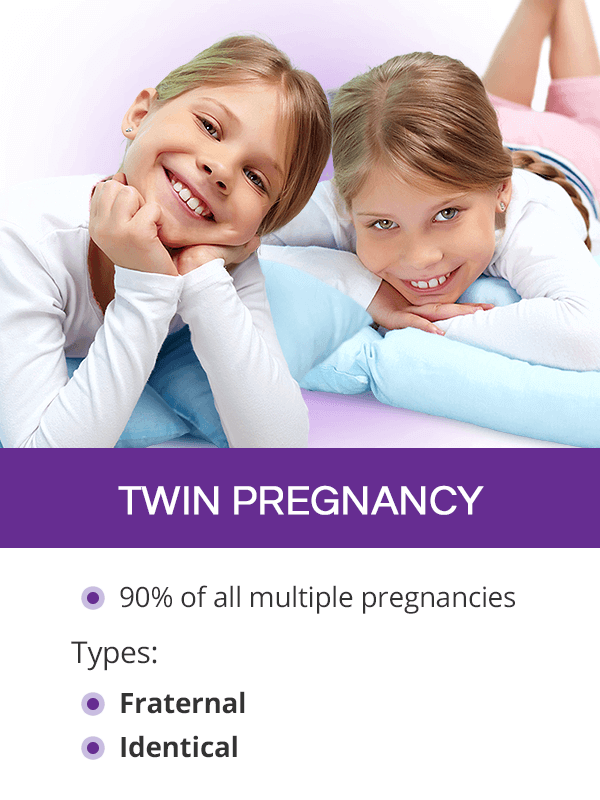
Twin pregnancies constitute the majority (90%) of all multiple pregnancies.1
Types of Twin Pregnancy
There are two types of twin pregnancy, depending on the way conception has occurred:2
Fraternal twins, called non-identical or dizygotic, result when ovaries release two eggs, which are then fertilized by two separate sperm cells. As such, they do not share the same genetic material. They typically run in families and are more common than identical twins (2/3 of all twin pregnancies).
Non-fraternal twins, called identical or monozygotic twins, result when an ovary releases one egg, which is then fertilized by one sperm cell and later splits into two eggs. Consequently, they share the same genetic material. They mostly happen by chance and are less common than fraternal twins (1/3 of all twin pregnancies).
Twin Pregnancy Risks
A twin pregnancy comes with an increased risk of pregnancy complications, including the following:
Risks for the Mother:
- Preeclampsia
- Gestational diabetes
- Cesarean section
- Miscarriage or stillbirth
- Postpartum depression
- Postpartum hemorrhage
Risks to the Babies
- Premature birth
- Low birth weight
- Birth defects
- Discordant growth
- Learning and behavioral disabilities
- Neonatal death
Additionally, there is an increased risk of further complications, including twin-twin transfusion syndrome (TTTS), during which one twin donates blood to another twin, resulting in imbalanced blood circulation to both babies.
Triplets or Other Multiples
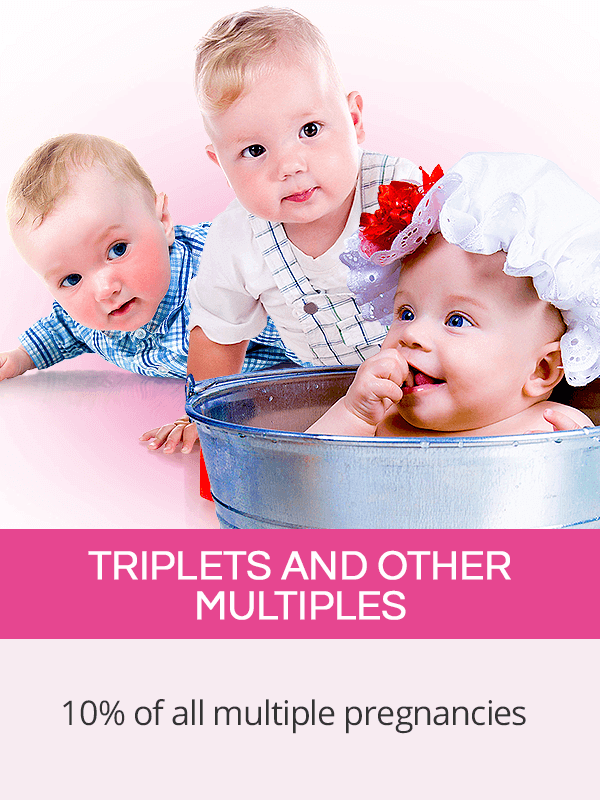
Higher-order multiples, such as triplets, quadruplets, and others, are less common than twin pregnancies, accounting for 10% of all multiple pregnancies.1
Types of Triplets or Other Multiples
Multiple pregnancies, like triplets and more, can be a combination of fraternal and identical multiples. This means that three or more eggs released from the ovaries can be fertilized and result in fraternal twins, or one released can split into several embryos. There could also be a combination of both scenarios.
If multiples are through IVF, they are generally fraternal.
Higher-Order Multiple Pregnancy Risks
Multiple pregnancies share all potential complications with twin pregnancies, including preterm birth and low birth weight; however, the risk of these complications significantly increases with the number of multiples.
A unique risk of complications observed in about 20% of triplet pregnancies is the fact that one of the babies is born with long-term disabilities, such as cerebral palsy. Additionally, 3/4 of triplets require intensive care.6
Signs and Symptoms of Multiple Pregnancy
Some of the most classic pregnancy signs and symptoms for multiple pregnancy will be the same as in the case of singleton pregnancies, but their severity might be more pronounced. They may include the following:
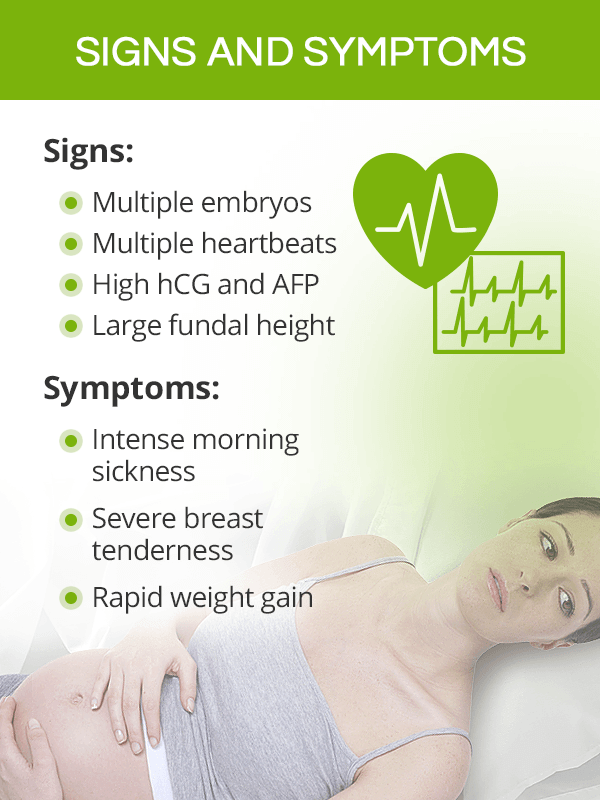
Symptoms of Multiple Pregnancy
- Intense morning sickness
- Severe breast tenderness
- Rapid weight gain in the first trimester
- Strong back pain and fatigue
Signs of Multiple Pregnancy
- Multiple embryos on ultrasound
- Multiple fetal heartbeats
- High levels of human chorionic gonadotropin (hCG)
- High levels of alpha-fetoprotein (AFP)
- Large fundal height
Carrying Twins, Triplets, and Other Multiples
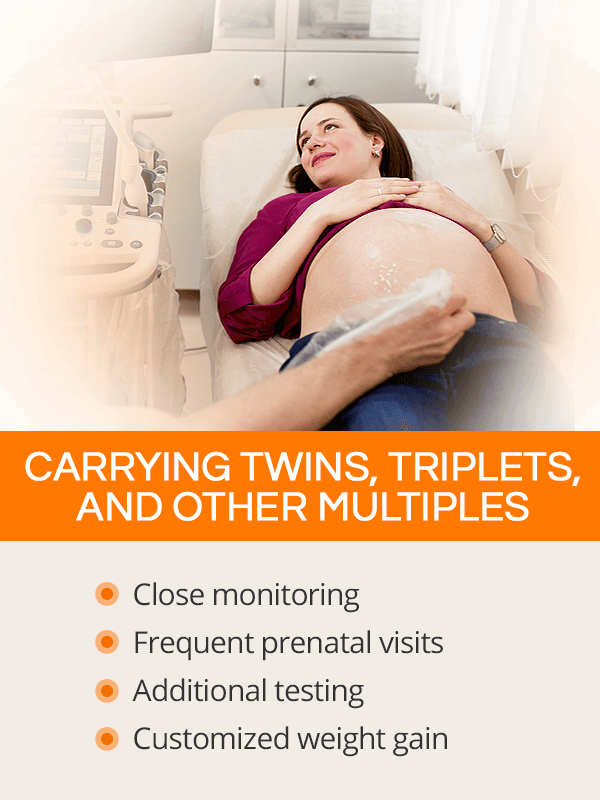
Without a doubt, carrying twins and higher-order multiples requires more attentive care during all pregnancy stages. These special needs can be satisfied with the following recommendations:
Frequent Prenatal Visits
To closely monitor fetal development and their own health, women pregnant with triplets and other multiples typically have their prenatal visit scheduled more frequently. They will also undergo additional prenatal testing, such as more frequent pregnancy ultrasounds or biophysical profile, to ensure that all babies are well.
Special Nutritional Needs
Because of a higher risk of low birth weight and other complications, women carrying multiples should consume a well-balanced, wholesome pregnancy diet with an additional 600 calories per day for twin pregnancies. Triplet and other multiple pregnancies should have an individualized calorie intake.3 Prenatal vitamins can help reach those requirements, too.
Customized Weight Gain Recommendations
Though weight gain during pregnancy is inevitable and necessary, it is important to gain a healthy weight. Women carrying multiples will follow different weight gain recommendations based on their pre-pregnancy body mass index (BMI), number of babies, and other factors.
Pre-Pregnancy BMI
Healthy Weight Gain with Twins5
Pregnancy weight gain for women pregnant with triplets and higher-order twins will be adjusted individually.
Giving Birth to Twins, Triplets, and Other Multiples
Because of a higher burden multiples place on the mother's body as well as shortage of space and nutrients, premature birth is 50% more common in twin pregnancies and even more common with other multiples compared to singleton births.3
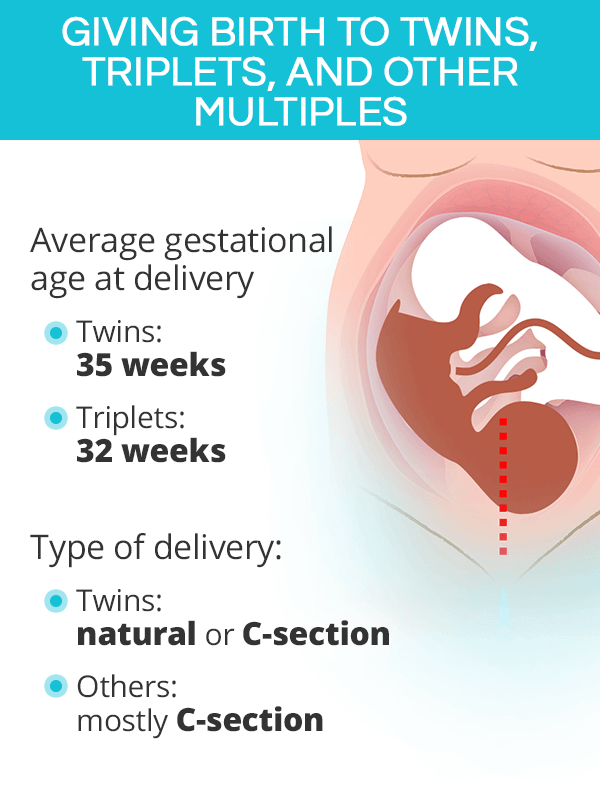
As such, average gestational age at the time of delivery in twin pregnancies is usually 35 weeks (as opposed to 37-40 weeks with singleton pregnancies). With triplets, the average is 32 weeks.6
Giving birth to twins naturally through a vaginal delivery might be possible if there are no other indications if both or at least the first twin is in the vertex position (with his or her head down). Otherwise, a C-section is a safer type of birth.
Giving birth to triplets and other multiples is most commonly done through a C-section.
Key Takeaways
The idea of carrying twins, triplets, or other multiples might be exciting for many women for various practical and personal reasons. However, multiple pregnancies come with a number of potential challenges that require closer monitoring and more individualized care. Of all multiple gestations, twin pregnancy (with both fraternal and identical twins) accounts for 90%, with triplets and other multiples making up the remaining 10%. Carrying multiple babies increases the risk of certain complications, most importantly premature birth, low birth weight, and preeclampsia, among others. Women are also more likely to have a C-section, especially when pregnant with triplets and higher-order multiples. As such, they require more frequent doctor's visits and additional testing to keep a close eye on the developing babies and their own health. Despite these challenges, medical advances continue to enable most multiple pregnancies to result in healthy infants.
Sources
- CDC. (2014). Multiple Births. Retrieved September 10, 2019 from https://www.cdc.gov/nchs/fastats/multiple.htm
- Journal of Perinatal Education. (2005). Childbirth Education for Multiple Pregnancy. Retrieved September 10, 2019 from https://www.ncbi.nlm.nih.gov/pmc/articles/PMC1595249/
- Medline Plus. (2019). Twins, Triplets, Multiple Births. Retrieved September 10, 2019 from https://medlineplus.gov/twinstripletsmultiplebirths.html
- Multiples of America. (n.d.). Multiple Births Statistics. Retrieved September 10, 2019 from http://www.multiplesofamerica.org/research-2/multiple-births-statistics/
- NHS. (2019). Getting ready for twins. Retrieved September 10, 2019 from https://www.nhs.uk/conditions/pregnancy-and-baby/preparing-for-twins-multiples/
- Pregnancy, Birth & Baby. (2017). Giving birth to twins. Retrieved September 10, 2019 from https://www.pregnancybirthbaby.org.au/giving-birth-to-twins
- Pregnancy, Birth & Baby. (2017). Multiple birth - triplets or more. Retrieved September 10, 2019 from https://www.pregnancybirthbaby.org.au/multiple-birth-triplets-or-more
- Pregnancy, Birth & Baby. (2017). Pregnant with twins. Retrieved September 10, 2019 from https://www.pregnancybirthbaby.org.au/twins-and-multiple-pregnancy
- Pregnancy, Birth & Baby. (2017). Types of multiple pregnancy. Retrieved September 10, 2019 from https://www.pregnancybirthbaby.org.au/types-of-multiple-pregnancy
Footnotes:
- Better Health Channel. (n.d.). Twins and multiple births. Retrieved September 10, 2019 from https://www.betterhealth.vic.gov.au/health/ServicesAndSupport/twins-and-multiple-births
- Office on Women's Health. (2019). Twins, triplets, and other multiples. Retrieved September 10, 2019 from https://www.womenshealth.gov/pregnancy/youre-pregnant-now-what/twins-triplets-and-other-multiples
- American College of Obstetricians and Gynecologists. (2019). Multiple Pregnancy. Retrieved September 10, 2019 from https://www.acog.org/Patients/FAQs/Multiple-Pregnancy?
- March of Dimes. (2017). Being pregnant with twins, triplets, and other multiples. Retrieved September 10, 2019 from https://www.marchofdimes.org/complications/being-pregnant-with-twins-triplets-and-other-multiples.aspx
- CDC: (2019). Weight Gain During Pregnancy. Retrieved September 10, 2019 from https://www.cdc.gov/reproductivehealth/maternalinfanthealth/pregnancy-weight-gain.htm
- American Society of Reproductive Medicine. (2012). Multiple Pregnancy and Birth: Twins, Triplets, and High Order Multiples. Retrieved September 10, 2019 from https://www.reproductivefacts.org/news-and-publications/patient-fact-sheets-and-booklets/documents/fact-sheets-and-info-booklets/multiple-pregnancy-and-birth-twins-triplets-and-high-order-multiples-booklet/
